In 1935, the US Federal Government decided to spend millions of dollars putting artists to work. What if they did it again?
Guests:
- Susan Quinn, author of Furious Improvisation: How the WPA and a Cast of Thousands Made High Art out of Desperate Times and other books.
- Monet Noelle Marshall, playwright, consultant, artist, director, founder of MOJOAA.
- Monica Byrne, novelist, playwright, futurist, activist.
Further Reading:
-
- Furious Improvisation: How the WPA and a Cast of Thousands Made High Art out of Desperate Times by Susan Quinn
- The New Deal Art Projects, An Anthology of Memoirs by Francis V. O’Connor
- Engendering Culture: Manhood and Womanhood In New Deal Public Art and Theater by Barbara Medosh
- American-Made: The Enduring Legacy of the WPA:When FDR Put the Nation to Work by Nick Taylor
- The Subsidized Muse: Public Support for the Arts in the United States by Dick Netzer
- The American Guide to the New Vermont
- After the Curtain Calls
- Creator of the Week with Monica Byrne
- What if Trump Really Does End Money for the Arts?
- Global Trends in Art Funding
- How the United States Funds the Arts
- Culturally Impoverished: US NEA Spends 1/40th of What Germany Doles Out for Arts Per Capita
- Why Are Americans So Hostile to State-Funded Art?
- Orson Welles’ Voodoo Macbeth: A forgotten diversity landmark
Flash Forward is produced by me, Rose Eveleth. The intro music is by Asura and the outtro music is by Hussalonia. The voice of your future president was played by Andrea Klunder, the Producer & host of The Creative Impostor and Podcast Envy podcasts. The episode art is by Matt Lubchansky.
If you want to suggest a future we should take on, send us a note on Twitter, Facebook or by email at info@flashforwardpod.com. We love hearing your ideas! And if you think you’ve spotted one of the little references I’ve hidden in the episode, email us there too. If you’re right, I’ll send you something cool.
And if you want to support the show, there are a few ways you can do that too! Head to www.flashforwardpod.com/support for more about how to give. But if that’s not in the cards for you, you can head to iTunes and leave us a nice review or just tell your friends about us. Those things really do help.
That’s all for this future, come back next time and we’ll travel to a new one.
FULL TRANSCRIPT BELOW
▹▹ ▹▹ ▹▹ ▹▹ ▹▹ ▹▹ ▹▹ ▹▹ ▹▹ ▹▹ ▹▹ ▹▹ ▹▹ ▹▹ ▹▹ ▹▹ ▹▹ ▹▹ ▹▹ ▹▹ ▹▹ ▹▹ ▹▹
Rose: Hello and welcome to Flash Forward! I’m Rose and I’m your host. Flash Forward is a show about the future. Every episode we take on a specific possible… or not so possible future scenario. We always start with a little field trip to the future, to check out what’s going on, and then we teleport back to today to talk to experts about how that world we just heard might really go down. Got it? Great!
This episode we’re starting in the year 2022.
[theme music up]
Naomi Walder (President): Hi, and welcome to the first ever episode of Speaker Side Chats. I’m Naomi Walder, you know, since I’m the president of the United States.
Franklin Roosevelt was the first president to do a weekly address, and he delivered his over the radio. He called them fireside chats, as I’m sure many of you know. I’m not the first president to deliver their address by podcast though. George W. Bush had a podcast back in 2001, if you can believe it. Later presidents turned to video for their addresses, President Obama and President Trump delivered their addresses by video. But I prefer the podcast medium, plus that means I can do this interview in my pajamas! (Just kidding, I’m not wearing pajamas)
Anyway, I’m really excited to spend this very first episode of the show on a really incredible announcement. Today we’re unveiling and discussing a brand new project, something we’ve dubbed Federal Project Number Two. The gist is this: we’re committing a billion dollars to fund the arts in the United States.
America is a cultural hub, we produce art that influences the entire world. But arts funding in this country is flagging, and artists are struggling. So I’m taking a page from Franklin Roosevelt again. As some of you may know, during his Works Progress Administration, he included a project called Federal Project Number One, which funded writers, playwrights, painters, sculptors and more. The result was a huge boom in art and writing and plays in the United States. And I think it’s high time we repeated that kind of a bold influx of experimentation.
With me for the rest of this episode are the leaders of this new project, and we’re going to talk about their plans for the money, and how they hope to implement Federal Project Number Two.
But first, a word from our sponsors…
Just kidding this is an official government podcast, you’re the sponsor with your tax dollars! Okay, let’s get into it.
[theme music out]
Rose: So, this future is one in which the United States decides to dump a bunch of cash into the arts. And, like the future president in our fictional intro said, this would not be the first time the United States government committed a chunk of money specifically for employing artists.
The first time, was by Franklin Delano Roosevelt, in 1935.
Susan Quinn: I think it was Will Rogers who said you know, as long as Roosevelt does something does anything even if he sets the capital on fire we’ll cheer because at least he will have gotten the fire started. People felt very desperate you know and really the country was probably on the edge of revolution and you know there were food riots in many cities and out in the countryside and the deep desperation, and up to 50 percent of people in cities were unemployed. So that was the context.
Rose: This is Susan Quinn, a writer and the author of the book Furious Improvisation: How the WPA and a Cast of thousands Made High Art out of Desperate Times.
Susan: about several powerful figures behind the federal arts project.
Rose: So in 1932 Franklin Delano Roosevelt gets elected as President of the United States. And he’s elected at a time when the US is in the midst of the Great Depression. Everybody is looking to FDR to do SOMETHING. ANTYHING almost. And the thing he does, is propose a huge amount of federal spending to try and get people back to work. In 1935, he passes something called the Emergency Relief Appropriation Act of 1935, which allocated $4.88 billion to the Works Progress Administration. Over the course of the entire WPA, the government would wind up spending $11 billion, total. That’s about $200 billion, in today’s money.
Susan: So the WPA mostly did things like hire people to build bridges or hire people to do of various kinds of industrial work.
Rose: If you’re an American, or honestly even if you’re not an American, you’ve likely heard of the WPA. And today the idea of the government spending a ton of money to try and improve the economy isn’t actually that surprising. But you have to remember, this is 1935. The United States government had never spent money like this before. There were LOTS of people who thought that this was an incredibly bad idea that would destroy the United States.
So the entire plan was controversial, and the fact that it actually included artists, at a time when people had no food…
Susan: It was a daring choice, it was one of the most, if not the most controversial part of the WPA.
Rose: And it only really happened because of two people.
Susan: Harry Hopkins an interesting figure in Iowa, an Iowa born person who came from a humble background but who was a passionate advocate for poor people. And so he and he understood as he said that artists have to work too!
Rose: So Harry Hopkins winds up being the head of the entire WPA.
Susan: And the other person who is very important was Eleanor Roosevelt. I don’t think that Franklin Roosevelt on his own would have been pushing so hard for including the arts.
Rose: So with Harry and Eleanor both pushing for the arts, FDR included them in the WPA, in what was called Federal Project One. Federal Project One was allocated about $27 million, which is around $490 million in today’s money. And Federal Project One was explicitly tasked with giving work to artists: writers, directors, actors, painters, printmakers, creators of all kinds.
Rose: Under Federal Project One there were four main departments: the Federal Arts Project, the Federal Music Project, the Federal Writers Project and the Federal Theatre Project. Collectively, these projects produced an incredible amount of artistic work.
Susan: The writing project is famous forever even, until now because the writing project set out to write histories of all the states in the union and they wrote these writers guides to the states which have now become part of our history. And they’ve really become very important documents about each of the states. And then the visual arts projects had an enduring also legacy. The murals of various kinds all around the country and there are good guides now to those murals. And also wonderful wonderful posters and they intersected and overlapped with the Federal Theater because they created these amazing posters. I have some of those that I have framed.
Rose: For this episode we’re going to dig a little deeper into the Federal Theatre Project, to see what it really looks like when you give artists a ton of money and tell them to go wild.
Susan: You know, Harry Hopkins had said promise at the beginning of the Federal Theater it would be free adult and uncensored.
Rose: But, as we’re about to see, that’s… not exactly what happened.
So the Federal Theater Project was run by a woman named Hallie Flanagan.
Susan: You know not the most obvious choice because she wasn’t in the New York theater. You know, she was in the experimental theater. And she taught at Vassar where she put on shows about her Vassar audiences about poverty and drought in the south. And Harry knew her from his undergraduate days at Grinnell as this really energetic, feisty woman who wouldn’t take no for an answer.
Rose: So Hallie is put in charge of this huge theatre project, and she immediately gets to work hiring directors and actors and organizing productions. And one of the first performances that she starts to organize is something called a Living Newspaper.
Susan: Which were plays which are based on what was happening right now and which challenged the audience to to get involved or to learn painful truths about what was happening.
Rose: Essentially these living newspapers dramatized things that were actually happening in the news. And in 1935, something happened in the news that Hallie thought would be the perfect thing to dramatize. On October 3rd, 1935, Benito Mussolini, the leader of Italy at the time, invaded Ethiopia. Mussolini saw Ethiopia as an easy target, and he was eager to expand the Italian empire.
This invasion was not really a popular move in Europe or in the United States. Most people sided with Haile Selassie, the emperor of Ethiopia, who was defending his country against this takeover. FDR privately sided with Selassie, but publicly, he didn’t get involved. Remember the United States is in the midst of the great depression, getting involved in a war in Europe is not exactly something that FDR could afford to do.
Hallie saw this news as the perfect fodder for a living newspaper production, which she called, simply, Ethiopia.
Hallie got the director Elmer Rice involved, who had won a Pulitzer Prize for his drama called Street Scene. And Rice and Hallie put together a production.
Susan: This first Ethiopia was about something that was in the news at that very moment. And of course that was the problem. There was lots of sympathy for Haile Selassie in the country but there were also others who sided with Italy, there were Italian Americans, so it was a controvercial subject.
Rose: The play was written by a team of newspaper reporters and playwrights.
Susan: The great virtue of these living newspapers was that they were going to they employed hundreds of actors because there would be that they would find ways of using lots and lots of actors to portray crowd scenes in different events.
Rose: There were three hundred people employed just for Ethiopia, actors, stage hands, lighting coordinators, writers. And then, two weeks before the play was supposed to open, FDR’s press secretary got wind of the production.
Susan: The way they told the story was very sympathetic Ethiopia, it was really taking sides in this battle. So suddenly the Federal Theater, you kno,w essentially the Roosevelt administration is presenting this play which touches on all these hot button issues. Well of course they panicked in Washington. So the play was essentially shut down before it could open.
Rose: Hallie and Elmer Rice put on one production of Ethiopia just for theatre critics in New York, but it was never performed for the public. Unsurprisingly, this was a blow not just for the production, but for the entire project. Newspapers sneered about all the money that the government had just spent on a play that nobody would ever see.
And this wound up being a little bit of a pattern for the Federal Theatre Project. Harry Hopkins had promised Hallie that she could do whatever she wanted with her new creative department. But … it was still funded by the United States government, so, that wasn’t really the case.
Despite these rules and setbacks, The Federal Theatre Project did wind up hiring tons of people and putting on a lot of ground breaking productions. Hallie was committed to using the project to further racial equality in the United States. She hired black and white artists, paid them exactly same wages, and had them working together. She presented plays to integrated audiences, which was a big deal in the 1930’s. In fact, Hallie had a policy at the Federal Theatre Project that if a theatre would not seat black and white people together, she would cancel the performance.
And perhaps the most famous production that came out of the Federal Theatre Project is something called “voodoo Macbeth.”
Susan: Which was an all black production of Macbeth in Harlem, directed by Orson Welles. That, even though it was Macbeth, the idea of doing you know, federal funds going to an all an all black production of Macbeth was at that time very controversial and surprising.
Rose: So, this production of Macbeth which everybody at the time called voodoo Macbeth, was a version of the play set on Haiti in the early nineteenth century. The witches from the original Shakespearean version were played by voodoo priestesses. And Orson Welles, the director, hired an entire cast of black actors for the play. Some of them were traditional theatre actors like Jack Carter who played Macbeth and Edna Thomas who played Lady Macbeth. The voodoo witches were played by an African troupe of actors led by Asadata Dafora Horton. Ultimately, the cast was over 100 actors, all of them black.
Here’s a clip from one of the performances. It’s actually from the very end of the play, so, uh, I guess spoiler alert? If you don’t know how Macbeth ends maybe skip this next little bit?
Enter MACDUFF
MACDUFF
Turn, hell-hound, turn!
MACBETH
Of all men else I have avoided thee:
But get thee back; my soul is too much charged
With blood of thine already.
MACDUFF
Then yield thee, coward,
And live to be the show and gaze o’ the time:
We’ll have thee, as our rarer monsters are,
Painted on a pole, and underwrit,
‘Here may you see the tyrant.’
MACBETH
I will not yield,
Though Birnam wood be come to Dunsinane,
And thou opposed, being of no woman born,
Yet I will try the last. Before my body
I throw my warlike shield. Lay on, Macduff,
And damn’d be him that first cries, ‘Hold, enough!’
Exeunt, fighting. Alarums
Retreat. Flourish. Enter, with drum and colours, MALCOLM, SIWARD, ROSS, the other Thanes, and Soldiers
Rose: Now, if you look at the photos from voodoo Macbeth today, you’ll see a lot of problematic costumes and tropes. The play wasn’t without its faults. And it was still directed by a white guy, Orson Wells. In fact, on opening night, there was nearly a riot outside the theatre. Here’s Welles talking about it on a French show in 1975.
Orson Welles: It was a big political event
Interviewer: It was a big political event, there had been riots in Harlem.
Welles: And there was a riot that night. The police were around because there was a big part of the black community that thought we were making fun of the blacks to make them in Shakespeare and people would go to laugh. So the police were there by the hundreds to stop people from throwing bricks and so on because the word had gone out that it was a, you know, a kind of burlesque. It was, au contraire, I spent a long time rehearing, I never rehearsed a play so long, three months.
Rose: Voodoo Macbeth opened on April 14, 1936 in Harlem. And despite those initial reservations, it was a HUGE hit. Macbeth went on to play in Harlem for ten weeks. It went to Broadway, and eventually toured America. It played in non-segregated theatres in Bridgeport, Hartford, Chicago, Indianapolis, Detroit, Cleveland and Dallas. All told over 150,000 people of all races saw the play.
In the 1930’s this play was a big deal for most people who saw it. Most audiences, white or black, had never seen black actors in any kind of serious dramatic role before. In a local paper called The Amsterdam News, writer Roi Ottley, who at the time was one of the most famous black journalists in the country, wrote that quote: “The Negro has become weary of carrying the White Man’s blackface burden in the theatre. In Macbeth he has been given an opportunity to discard the bandanna and burnt-cork casting to play a universal character.”
So this is the kind of theatre that came out of the Federal Theatre Project in the 1930’s. It was weird, groundbreaking, sometimes good, sometimes bad, but always surprising.
Susan: Well nother one and this is a sensational event, a historic event, and that was the production of The Cradle Will Rock which was a musical play written by Marc Blitzstein and it was a critique a very really radical angry critique of company town and of the attempt to start a union in a steel town.
Rose: The hero of the play is a union organizer, and the villain is a greedy businessman named Mr. Mister who owns everything in town, the factory, the press, the church, everything.
Susan: It’s a classic and continues to be revived. The songs are powerful and that production was shut down by the government before it even opened. And then Orson Welles who was leaving the church was directing rebelled and produced it not on government money but it was really it was really Hallie Flanagan’s initiative and the support of the government to put it together to make it happen.
Rose: There were also some smaller productions that might not have gotten as much attention, but were beloved by audiences. And all of this was, again, 100% funded by the United States government. And that eventually became its downfall. In 1939, Hallie and her wild theatre experiment, both met the scrutiny of the House Un-American Activities Committee.
Susan: that they claimed the Federal Theatre was communist and that was the reason that they attacked it and the reason that it threatened them. But the real reason we had to do with racism and the fact that the Federal Theater shockingly insisted on integrating performing before integrated audiences, promoted black theater all black theater pieces like voodoo Macbeth, but also had a lot of integrated productions, and those hearings focus a lot on the fact that there were there were integrated productions blacks and whites working together. They found this white woman who reported to the committee that she’d been asked out on a date by a black man, and that became a big focus of the shock of the committee. So you know there was this underlying panic, I would say by the Southern senators about the fact that the federal theatre was crossing all kinds of lines including race lines.
Rose: The Federal Theatre Project only lasted four years, but over that time, it was able to do a lot of really interesting and surprising things. And I’m telling you about these successes and failures of the Federal Theatre Project, because reading Susan’s book got me thinking about whether or not something like this could ever happen again.
So this is our question today. Would the US ever do this again, and if so, what would happen? Susan is skeptical that today’s federal government would go for it.
Susan: It’s OK to fund bridges and roads but it’s not OK to fund art because that’s, that’s a frill. And of course one of Hallie’s arguments along the way was that art is necessary as opposed to being extra. Which I believe too, but I think gosh we have to come an awful long way back from where we are now that really invest in free adult uncensored theater funded entirely by the federal government. I can’t imagine it happening. I wish it would.
Rose: But let’s take what we’ve learned about history and try to predict the future a bit now, shall we? What would happen if there was a big, specific arts funding project, outside the current funding schemes? How would it benefit artists? How would it change their work and worlds? And what might it mean for those who aren’t artists?
All that and more after this quick break.
[[ADS]]
Rose: Okay so in 1935 FDR gave the arts a bunch of money. That money funded a lot of pretty interesting art. It wasn’t perfect art, it wasn’t art without flaws, it wasn’t art without an agenda. The writers guides, funded by the Federal Writers Project, for example, were very specifically a nationalist propaganda project, and often included a whole lot of whitewashing about the states they profiled. But what about now? How does today’s art funding in the US compare to the WPA?
Let’s look at some numbers. In 1935, the idea of the US government spending billions of dollars on projects like this was pretty much unheard of. Today, the US government has a much bigger hand in what goes on and how it’s funded. In 1933, before FDR’s New Deal, the entire federal budget was about $4 billion. In today’s money about $77 billion. The current federal budget for 2018 is $4 trillion.
But looking at the arts in particular something interesting pops out. Federal Project One, the arts wing of the WPA, was allocated $27 million in 1935 money, which is about $495 million today. So I wanted to know, how much is US spending on arts today. Surely it’s less than what the WPA spent But actually, the US government spends $741 million on three different arts organizations: the National Endowment for the Arts, National Endowment for the Humanities and the Corporation for Public Broadcasting.
So the US does spend a lot of money on art every year. More, in fact, than it spent on Federal Project One over the few years it existed. But before all the Americans listening start patting themselves on the back, let’s compare that spending with other countries. So remember, the US spends about $740 million each year on the arts. Germany spends $1.63 billion, Australia spends 7 billion and France spends nearly $10 billion dollars. And it’s worth noting that all three of those countries have populations far smaller than the United States.
Other countries might not spend as much, but they have developed other innovative ways to support artists. Mexico, for example has a system where if an artist is able to sell five artworks in a year, they can offer to pay their taxes to the government artwork via art. The government then exhibits that art in museums and government offices, and loans the pieces out for special exhibitions.
So not only does the United States spend way less, it also spends way less energy trying to figure out how to support artists. I’ve read a lot about why this might be, and there are plenty of theories. A lot of people argue that it all comes back to cultural identity. Americans, even though the United States is one of the biggest producers and exporters of culture in the world, don’t identify art as something that’s inherent in their identity. Americans are hard workers, independent thinkers. The American spirit is unbreakable, the land is beautiful, the people are scrappy and independent. If you asked people to draw an American, it would more likely be someone driving a truck than someone sitting at an easel painting.
Compare that with France, whose national identity is deeply rooted in the kinds of art and culture that it produces, and you can see why France might spend $150 per person per year on art, while the US spends a measly $2.3 dollars.
So, that’s a lot of numbers. But what does all of this actually mean for American artists today?
Monet Noelle Marshall: It is feast or famine. Either people are loving your art, and mainly when they’re loving it, that means that you have tapped into some like zeitgeist of a moment or you have created a moment or you just really created community around yourself. But if you haven’t done those things or if the community you created around yourself don’t have access to wealth in the same way, then it’s a lot of trying to convince people why you should be able to eat food in exchange for your art.
So my name is Monet Noelle Marshall. I am a theater artist, a racial equity consultant, and it’s just like a big theater kid.
Rose: Monet is based in Durham, North Carolina, and she’s working with a couple of other artists there to try and get the city to rethink the way its funding art.
Monica Byrne : I mean because one of the biggest reasons people are like “oh move to Durham move to Durham” is because because of its great arts and culture scene and that is true! What you don’t see is that you are letting that very population become impoverished and become unable to keep doing the things that you keep saying you know Durham is great for.
My name is Monica Byrne. I am a writer and a playwright and an activist based in Durham North Carolina.
Rose: So I wanted to talk to Monica and Monet because I wanted to understand the current funding situation for artists in the United States today. We know the US government does fund art. In fact, it technically spends more every year on art than Federal Project One did. But how do actual artists get that money?
Monica: I mean that that’s the question that we keep coming back to and circling around over and over in all these meetings. Right now I have the impression that the city council and the mayor give money to the Durham Arts Council. Basically they work for the city on contract and they’re called the Durham Arts Council and the city owns the building that they work in in the middle of downtown. It’s a beautiful building. They have full time staff that they pay. They give away something like, it’s less than 10 percent of their budget in direct grants to artists, which is unusual it’s unusually low.
Rose: And this is something I heard a lot from the artists I talked to informally for this episode. Figuring out how to actually access all the money the US is spending on art is really hard. It’s especially hard if you aren’t already really well connected.
Monet: Funding, so much about funding it’s about trust and it often feels like the funders don’t want to trust you until someone else has trusted you. So you need someone to trust you with the money so that other people give you money which again, this becomes its own cycle. So what a lot of companies end up doing. Often they’re created by folks who already have wealth and or are connected to folks with wealth. So their initial budgets and funding are coming from their family and friends.
That is not the story of my company. [laughs] My company is run by myself and my family like, the name of our company is literally my name and my brothers Jordan and Aaron’s name mushed together to make MOJOAA and when we did our first show like we were literally paying people out of our own pocket and not paying our cell phone bill so that we can make sure that everyone got paid what we said we would pay them. And it’s just now like in our fourth year that we have received our first like bit of money. And it’s not even a lot by any means or measure.
Rose: And a lot of the organizations in charge of doling out that money, spend a TON of it on their own operations budgets. It’s not just Durham. In Portland, Oregon, for example, there’s an arts tax. City officials who proposed the tax promised that no more than five percent of the money gathered would be spent on overhead or administrative activities. But last year, tax payers in Portland learned that the number was a lot closer to eight percent, totaling a million dollars between 2012 and 2015.
In light of this, a lot of artists turn elsewhere for funding. You’ve probably heard about some of these other income streams: Kickstarter, Drip, Patreon, Paypal, Gofundme. Monica currently uses Patreon to fund the majority of her work.
Monica: So my patrons know that they are supporting all of the social media work I do all of the advocacy all of the activism which is you know obviously free. You know it’s for everybody it’s publicly available and visible and then they get access also to creative work like short stories or like previews of plays I’ve written or scripts or treatments things like that that people seem to appreciate. So that that is how the model works it’s basically you. It’s the old school form of patronage, arts patronage, which is very very old. Updated to the modern world.
Rose: Patreon lets people who like your work, give you money regularly for that work. Monica currently makes about $2800 a month on Patreon. Her goal is $3500 a month, which would mean that Patrons were paying for pretty much all of her art and time.
So I guess here is where I should say that Flash Forward has a Patreon too. In fact, part of the reason I was interested in doing this episode, this particular future, is that I know pretty well the struggle of funding art. This show, Flash Forward, isn’t exactly ART in the way you might think of art. It’s not a painting or a sculpture or a photograph or a play. But it is a form of creative work, and it’s creative work that requires money to continue doing. And I think that talking a little bit about the realities of Flash Forward’s current funding situation might be instructive here.
A lot of people right now think that podcasts are big business, that podcasters like are raking in a ton of money from mattress brands and meal kits and so on. That’s certainly true for some shows but it’s actually not true of most shows. It’s definitely not true for Flash Forward. Right now money for this show comes from two place: advertisements and Patreon. On Patreon right now, I make about $800 an episode.
Advertisements on the show are a little bit trickier. I say no to a lot of advertisers who I think are selling things that are unethical or based on pseudoscience. I also don’t take advertisements from companies that sell things that I might wind up covering on the show. I don’t personally endorse products on this show either — for me it’s important to have a journalistic line in the sand for ads. No shade to other podcasters who do it, but you’re never going to hear me personally vouch for a mattress or a bra. That means that Flash Forward isn’t as appealing to advertisers as other shows might be. And there are a LOT of other shows for them the choose from. Right now I make less every episode on ads than I do from Patreon.
What that means is that a good episode of Flash Forward makes me about $1200 to $1500. That’s before I pay for things like hosting and artwork and transcription services. Now consider that each episode takes me about 60 hours to complete, between researching, interviewing, logging, scripting, cutting, mixing, everything. The math doesn’t exactly come out in my favor here.
I’m not telling you this so you’ll feel bad for me and go give me money on Patreon or whatever, although I certainly wouldn’t be mad if you did that. I’m telling you this because I bet it will surprise a lot of you. Flash Forward is well regarded. The show’s been featured in WIRED, Popular Science, Indiewire, USA Today. Most people I meet who know the show think that I must be making a lot of money doing it. I’m not, not even close. In fact this year the show is just going to barely scrape by. Next year is a big question mark.
Okay, well, that was pretty embarrassing to admit. I actually considered cutting this entire section about Flash Forward’s money, um, and I might still take it out before the final cut of this episode goes out? It’s not exactly fun to admit that your show isn’t doing as well as your listeners probably think it is. I’m sure some of you are even thinking: wow, you’re really embarrassing yourself right now please stop. But I am telling you this because I think it’s worth pulling back the curtain a little bit. I’m hustling for Flash Forward, I have a lot of irons in the fire, I’m applying for grants, I’m cold emailing possible advertisers, I’m trying to make my Patreon offerings more enticing, I’ve got some development deals brewing. I’m teaching myself how to be better at the business side. But that all takes time too, time I would love to be using on, you know, making this show better. I just don’t know if I think that every artist should also have an MBA to be able to succeed.
And this is actually really common for artists — lots of artists might seem successful, but they’re not necessarily making MONEY.
Monica: So you know people consider me a very successful artist right because I gave a TED talk. And I published a novel. What people don’t know is that TED speakers The same year that I spoke at TED I made 13000 dollars for like gross for the entire year and it was extremely hard. And I had to go on government assistance. And so it was a really strange space being in this space where everyone was like “oh my god your TED Talk was so awesome!” And I was like “Thanks! I can’t leave the house because I can’t afford to!” you know, it was very strange, but that is a perpetual situation of successful artists I know.
Rose: Now, some of you might say: well, if nobody is buying your art then that’s the market deciding. But, I’m not sure that’s the best way to measure whether a piece of art, or an artist, is worth funding.
Monet: So for me I do time based work which means that it’s very ephemeral that I cannot sell you my performance or to hang on your wall. You have to come and have an experience with me in some way shape or form. So I can’t just say like “Oh right. Let me just like create a thing real quick so I can sell it on etsy.” That’s just not how my art works. And for me, as a queer black woman creating art, there are so many layers and stories related to my identity, and also related to the art that comes out of me that is also tied to race and gender and sexuality and class. So we can’t just say “well just sell your art” because our access to people who have capital are going to be different depending on our place in society as well.
Rose: And I think that’s it’s worth spelling out the bigger reason to support art of all kids, beyond ticket sales or auction values or even the monetary value that art can bring to a city.
Monica: Our entire culture runs on art. One thought experiment I really love to have people do is to imagine their lives imagine their week imagine just their day waking up and there is no art, there is no art period. So all of your bookshelves are empty. You never hear any songs you never listen to any podcasts. Journalism I consider art and so there’s no NPR. But there you know the clothes you wear are like khaki jumpsuits and the food you eat is, you know comes in boxes. It’s just the world so much more dim and sad and boring and lifeless without art. Everything that you see and hear and do and wear and eat was designed by an artist of a very of various kinds and the vast majority majority of those artists did not get paid enough.
Rose: So let’s say that Monica and Monet convince the US government, there’s a new Federal Project, we’ll call it Federal Project Two. What next?
Monet: Number one I would want to know who has the purse strings. Who is the one, who are the people who get to decide who gets funding what states get how much money how are they measuring that? Is it like per capita is it a per capita? Plus we’re going to add in some racial equity or some class equity, or, that would be like my biggest question.
Monica: Well I’ll tell you a huge thing they could do with a million dollars is buy a building they could buy a building for artists in the city in downtown. That is something we keep asking them and pushing them to do which is to just buy one dedicated building that the city owns and then that artists can rehearse in for very cheap rates they can perform in for very cheap rates.
Monet: I would also want to know if they are taking into account like once they get the money locally how who is managing that once the money is coming to each state or in each region because there’s already so many politics around who gets funded and who doesn’t, and those relationships are long lasting in different cities and different areas.
Rose: The details of how the money gets handed out would be really complicated, but one thing Monet and Monica both stressed the importance of figuring out how to make sure this money was distributed not just to the big name artists living in New York or LA, but to artists local to smaller cities too.
Monet: People want a certain level of quote unquote professionalism in the art as if there are not artists who are living and existing in making in Durham who have all the talent or the skill but maybe haven’t had the opportunities to work on larger projects. So that becomes a cycle where oh let’s bring in the artist who’s from Brooklyn who’s with them Coachella because they’ve worked on a project with a million dollar budget, but that still means that local artists are not getting these opportunities. And then it just becomes a self-fulfilling prophecy. It’s like well there’s no one here who’s worked on that budget, and I’m like well you’re not hiring anyone here to work on something that large.
Rose: Local artists can also make work that resonates better with local people. If the idea of this big funding push is not just to produce more art, but also to get more Americans engaged in art, consuming art, seeing art, then that art needs to speak to them personally.
Monet: Something happens when an artist is making art that is very specific to their community because they are speaking to the issues, concerns, and they are speaking in the language of their neighbors. So for instance we had a Durham Performing Arts Center and we get a lot of bus and truck shows. So like Hamilton is coming and the Lion King has been here in Newsies and all that. And all those shows are great and large and beautiful and you know wonderus the people who are performing in them are not also shopping at the Kroger and putting their kids into school, in the same schools. They can’t tease out the nuance of what it means of how the story the Newsies connects to like labor in Durham. Right? But the artist who’s living you know on Vale Street can speak to the issues that are happening on on Main Street in downtown Durham, because they’re tapped into their community community in that way. Then the art can then have a greater impact because there’s greater resonance.
Rose: Hallie Hatfield, the head of the Federal Theatre Project, actually recognized this too. She would run shows put on by local theatres about more local issues.
But one thing the Federal arts project didn’t always do a great job of, was finding underrepresented artists to work with. And that’s something that Monet and Monica hope would be different about this theoretical new arts funding dump.
Monet: So for instance if we’re thinking about dance, we can think about dance as like ballet modern contemporary even the dance that study the day that is practiced in universities or in our large art spaces. But what about the underground dance? What about like that dance that are sprouting up in people’s basements and on street corners and at party. Like I think about Lil Buck and like his Memphis Juke style. Who is really working to make sure that those folks who have been creating art and art that is then like trickled up and also mutated over time to be become like a reference in a contemporary art piece on mainly white bodies. How are we flipping that how do we use this funding to flip that to make sure the funding is going to the queer black bodies who are creating the dance moves to begin with.
Rose: Okay so the cities get this money. They give it out to artists, those artists make work. The next thing that probably happens is… controversy. Just like Hallie Hatfield faced censorship and blowback from politicians, blowback that ultimately led to the end of her entire project.
This already happens today. In 2016, you might remember some controversy over a play dubbed “Doggie Hamlet” which received funding from the National Endowment for the Arts. Here’s Republican Senator James Lankford, from Oklahoma, discussion the play on CSPAN.
James Lankford: But it’s an outdoor production where they chase sheep and dogs around a big pen and do a big performance on it. I’ve seen some of the clips of the performance, again, it’s fine if a local community wants to do that, I’m just confused why the people of Oklahoma are paying for the production of doggy Hamlet in New Hampshire.
Or, more recently, people raised questions about why the government was spending money on a video game that introduced players to Henry David Thoreau’s Walden Pond.
Fox News Anchor: A peaceful walk to writer Henry David Thoreau’s Walden Pond, on your computer. The video game is funded by tax dollars. A $100,000 grant this year from the National Endowment for the Humanities. The goal according to the project’s website to quote “gain insight into the natural world.”
Steve Russell: I’ve got an idea why don’t you just go outdoors and look at trees! That doesn’t cost the American taxpayer anything.
Fox News Anchor: Oklahoma Congressman Steve Russell says tax dollars shouldn’t pay for it.
Russell: We have to draw the line, nineteen trillion dollars in debt.
Rose: Or perhaps you remember the infamous Piss Christ — a photograph by an artist named Andrew Serrano. The photograph is of a plastic crucifix submerged in a yellow liquid which Serrano explained was indeed his own urine. Now, this photograph was made in 1987, and Serrano won some awards from the NEA for his work which came with a total of $20,000. And that set off a big controversy at the time over what the US government should fund, when it comes to art. And Piss Christ has continued to cause controversy as recently as 2012, when it was displayed in a gallery in New York City. Not a government museum or anything, just a gallery. But religious groups at the time called on President Obama to officially, publicly condemn the image, which he didn’t do. Here’s Fox News discussing the art, and the backlash, in 2012.
Greg Gutfeld: Alright, Baron, why hasn’t President Obama stopped Piss Christ from being displayed and how quickly can we impeach him?
Chris Barron: Tomorrow? Hasn’t it already happened? I’ll tell you what. First off, the whole Piss Christ thing is offensive, and I am disgusted that there were any tax dollars spent on it. However, the answer is not to have Obama come out and denounce it.
Rose: I could go on and on with examples like this. Art is often provocative, and when that art is funded by the government, it can become a flashpoint. And remember, none of these recent examples were FULLY funded by the government, the way that the Federal Theatre Project was. So if there was another big push, where the federal government was FULLY funding entire pieces of art, there would inevitably be these conversations about what is and isn’t appropriate for the US to fund.
Monet: Because there are definitely plenty of folks folks who don’t know who I love their art who are making very American art even though even if it isn’t, like, pro America.
Rose: And artists know that. They’re very aware that the money they get might impact the kinds of art they produce.
Monet: You know if you are an artist and you need funding to make your art to pay your bills and eat food then you are going to be really wary of biting the hand that’s feeding you. So I think it’s more of a, is the artist, like what is the repercussion and how would the new federal this new Federal Arts Project Two, how would it then create some safeguards for these artists to be so it increased censorship around their art
Rose: So it’s easy to predict that there would be controversy surrounding whatever art came out of this new big federal project. But what else might happen? We can look back at Federal Project One and see a project that funded artists that went on to do really amazing things: Jackson Pollack, Mark Rothko, Studs Terkel, Zora Neale Hurston. The murals from the WPA project are still around. The guidebooks to the states are still in print.
But what might happen if we tried it again, is… almost impossible to tell. Which is the incredible or scary thing about art, depending on who you ask. When I do episodes about science and technology, it’s a lot easier to predict what might happen. But the exhilarating thing about art, the thing that makes it so wonderful, is that it’s inherently unpredictable.
Monica: I think the effects are in my mind. The effects are completely unpredictable and completely thrilling. Here’s why. I started watching Beyonce’s Coachella performance and I got through about five minutes of it before of just sobbing. And I asked myself why I was sobbing. Part of it is because the excellence of the artistry on display. And on the other hand because I know that there are a hundred other people like her. There are 100 other geniuses like her who got their wings clipped at age 3 age 5 age 10 18 age 25 age 30. And I think if you even, if you even put a little bit of money into all of the untapped talent in the United States it would be like sewing… [laughs] it would be like bamboo growing. You know you would just it we would all sprout up and you would be floored by the amount of things that we do and the amount of talent that there is.
Monet: There could be art that is being made right now that we don’t even have words for yet and we want to be able to have room to fund it because that could be the next thing. And I actually think that that is the most quote unquote American piece around innovation, and you don’t I don’t know what this is yet and we don’t know what it is but we need to leave room for it. So if we are funding differently and we are funding in a way that folks of color women and queer folks trans folks have the same access or have more access to funding then that means that they can then impart who they are and the truth of their lives into our into our cultural narrative, in a way that tells a whole story of our country and we would all be better for it.
Monica: If you know every city got a million dollars for to fund grassroots independent artists. Oh my god just stepped back. [laughs] That’s all.
[Flash Forward credit music up]
Rose: That’s all for this future. Flash Forward is produced by me, Rose Eveleth. Special thanks to my guests this week, Susan Quinn, Monica Byrne and Monet Marshall. Check out Susan’s book, Furious Improvisation: How the WPA and a Cast of Thousands Made High Art out of Desperate times. You can find more about her other books at http://susanquinnbooks.com/. Monica Byrne’s work can be found at https://www.monicabyrne.org/ that’s byrne. Or by going to Patreon.com/monicabyrne. You can learn more about Monet Noelle Marshall’s work at http://www.monetnoellemarshall.com/ or check our her theatre company MOJOAA at https://www.mojoaa.org/ that’s M O J O A A dot org. You can find all these links and more in the show notes, or at Flashforwardpod.com
The intro music is by Asura and the outtro music is by Hussalonia. The voice of your future president was played by Andrea Klunder, the Producer & host of The Creative Impostor and Podcast Envy Podcasts. The episode art is by Matt Lubchansky.
If you want to suggest a future we should take on, send us a note on Twitter, Facebook or by email at info@flashforwardpod.com. We love hearing your ideas! And if you think you’ve spotted one of the little references I’ve hidden in the episode, email us there too. If you’re right, I’ll send you something cool.
And if you want to support the show after hearing my sob story about Flash Forward’s economics, there are a few ways you can do that too! Head to www.flashforwardpod.com/support for more about how to give. But I really do recognize that not everybody can or wants to donate money, and that’s totally fine. If you want to support the show some other way, you can head to Apple Podcasts and leave us a nice review or just tell your friends about the show. Those things really do help.

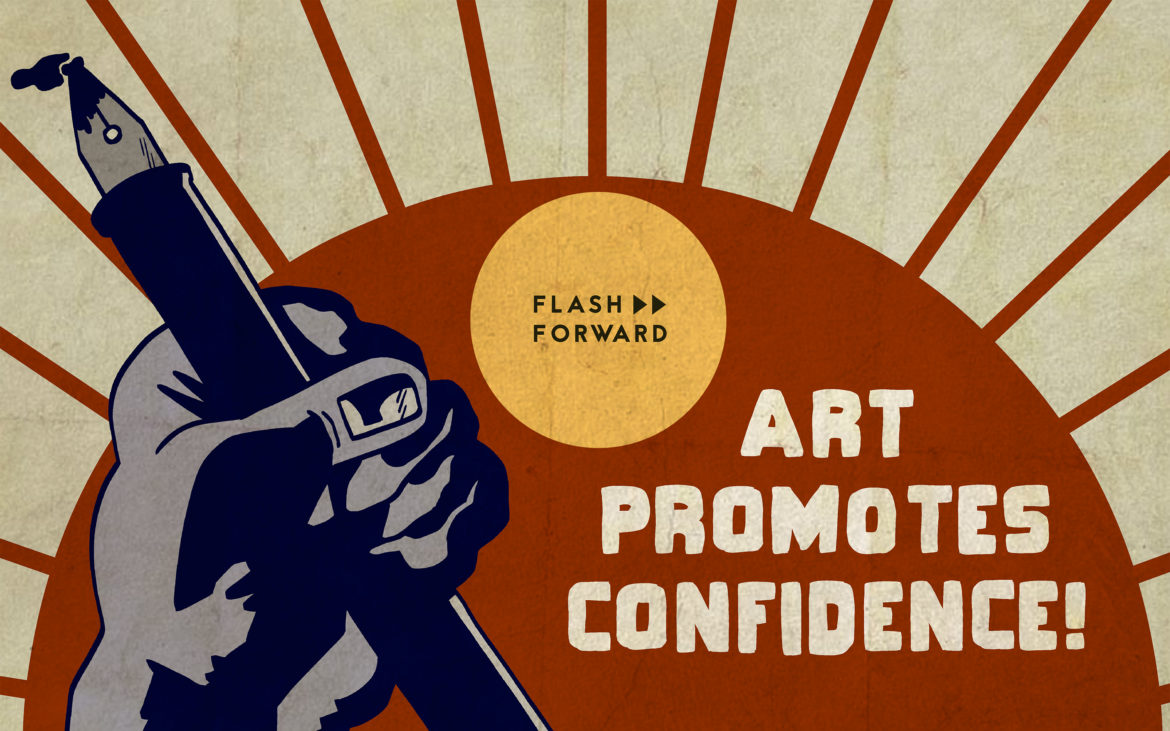
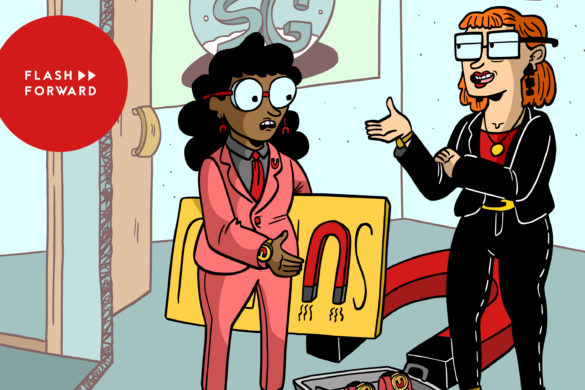
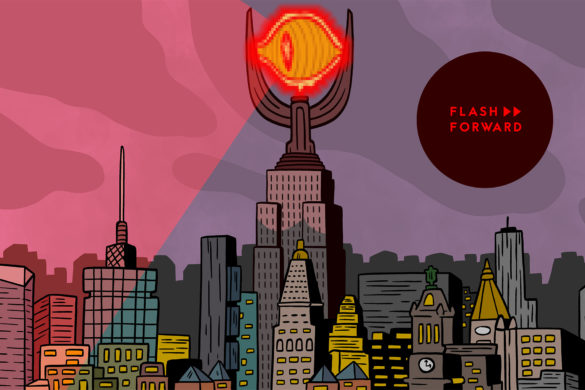

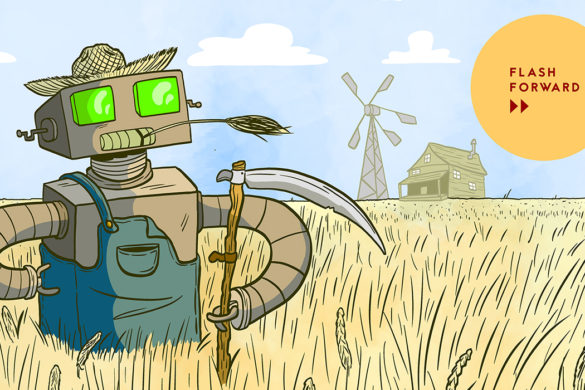
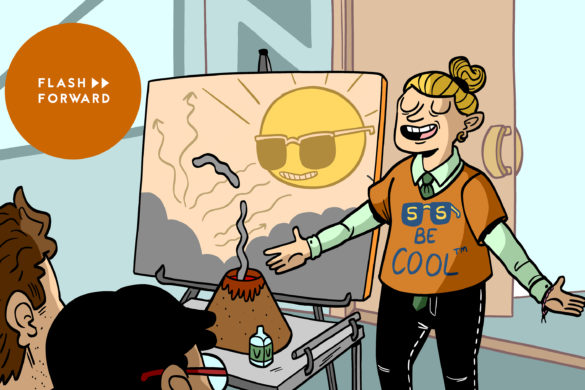

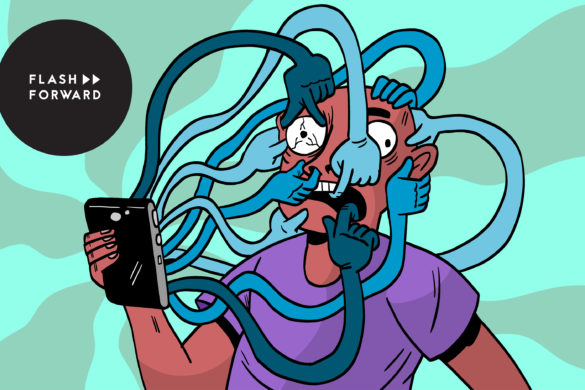
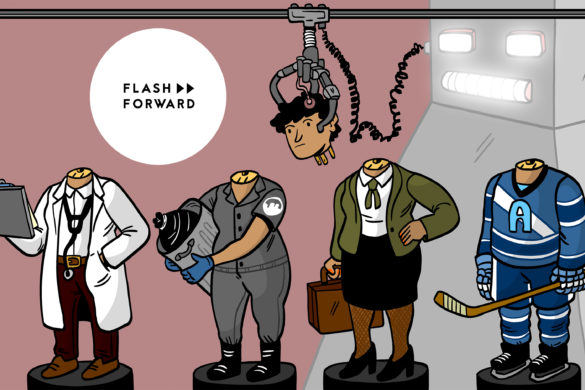
2 comments
[…] itself to the excellent recent Flash Forward episode about an issue near and dear to my heart — arts funding and the WPA. Watercolor, marker and Micron […]
[…] FLASH FORWARD: Federal Project Two (a second New Deal) […]